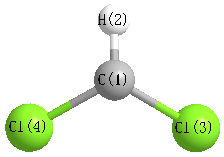Jump to
S1C2
Energy calculated at CCD/TZVP
| | hartrees |
|---|
| Energy at 0K | -957.847035 |
| Energy at 298.15K | |
| HF Energy | -957.417485 |
| Nuclear repulsion energy | 125.098760 |
The energy at 298.15K was derived from the energy at 0K
and an integrated heat capacity that used the calculated vibrational frequencies.
Vibrational Frequencies calculated at CCD/TZVP
| Mode Number |
Symmetry |
Frequency
(cm-1) |
Scaled Frequency
(cm-1) |
IR Intensities
(km mol-1) |
Raman Act
(Å4/u) |
Dep P |
Dep U |
|---|
| 1 |
A1 |
3326 |
3153 |
0.00 |
|
|
|
| 2 |
A1 |
764 |
724 |
10.94 |
|
|
|
| 3 |
A1 |
316 |
300 |
0.41 |
|
|
|
| 4 |
B1 |
441i |
418i |
50.48 |
|
|
|
| 5 |
B2 |
1300 |
1233 |
59.44 |
|
|
|
| 6 |
B2 |
947 |
897 |
134.23 |
|
|
|
Unscaled Zero Point Vibrational Energy (zpe) 3105.6 cm
-1
Scaled (by 0.948) Zero Point Vibrational Energy (zpe) 2944.1 cm
-1
See section
III.C.1 List or set vibrational scaling factors
to change the scale factors used here.
See section
III.C.2
Calculate a vibrational scaling factor for a given set of molecules
to determine the least squares best scaling factor.
Geometric Data calculated at CCD/TZVP
Point Group is C2v
Cartesians (Å)
| Atom |
x (Å) |
y (Å) |
z (Å) |
|---|
| C1 |
0.000 |
0.000 |
0.675 |
| H2 |
0.000 |
0.000 |
1.749 |
| Cl3 |
0.000 |
1.484 |
-0.171 |
| Cl4 |
0.000 |
-1.484 |
-0.171 |
Atom - Atom Distances (Å)
| |
C1 |
H2 |
Cl3 |
Cl4 |
| C1 | | 1.0737 | 1.7080 | 1.7080 |
H2 | 1.0737 | | 2.4261 | 2.4261 | Cl3 | 1.7080 | 2.4261 | | 2.9682 | Cl4 | 1.7080 | 2.4261 | 2.9682 | |
 More geometry information
More geometry information
Calculated Bond Angles
| atom1 |
atom2 |
atom3 |
angle |
|
atom1 |
atom2 |
atom3 |
angle |
| Cl3 |
C1 |
H2 |
119.670 |
|
Cl3 |
C1 |
Cl4 |
120.661 |
| Cl4 |
C1 |
H2 |
119.670 |
|
Electronic energy levels
Charges, Dipole, Quadrupole and Polarizability
Jump to
S1C1
Energy calculated at CCD/TZVP
| | hartrees |
|---|
| Energy at 0K | -957.848306 |
| Energy at 298.15K | -957.849178 |
| HF Energy | -957.419286 |
| Nuclear repulsion energy | 124.976073 |
The energy at 298.15K was derived from the energy at 0K
and an integrated heat capacity that used the calculated vibrational frequencies.
Vibrational Frequencies calculated at CCD/TZVP
| Mode Number |
Symmetry |
Frequency
(cm-1) |
Scaled Frequency
(cm-1) |
IR Intensities
(km mol-1) |
Raman Act
(Å4/u) |
Dep P |
Dep U |
|---|
| 1 |
A' |
3280 |
3109 |
2.24 |
|
|
|
| 2 |
A' |
773 |
733 |
16.93 |
|
|
|
| 3 |
A' |
560 |
531 |
17.58 |
|
|
|
| 4 |
A' |
310 |
294 |
0.48 |
|
|
|
| 5 |
A" |
1302 |
1234 |
53.40 |
|
|
|
| 6 |
A" |
915 |
867 |
156.00 |
|
|
|
Unscaled Zero Point Vibrational Energy (zpe) 3569.6 cm
-1
Scaled (by 0.948) Zero Point Vibrational Energy (zpe) 3384.0 cm
-1
See section
III.C.1 List or set vibrational scaling factors
to change the scale factors used here.
See section
III.C.2
Calculate a vibrational scaling factor for a given set of molecules
to determine the least squares best scaling factor.
Geometric Data calculated at CCD/TZVP
Point Group is Cs
Cartesians (Å)
| Atom |
x (Å) |
y (Å) |
z (Å) |
|---|
| C1 |
0.013 |
0.702 |
0.000 |
| H2 |
-0.508 |
1.645 |
0.000 |
| Cl3 |
0.013 |
-0.172 |
1.479 |
| Cl4 |
0.013 |
-0.172 |
-1.479 |
Atom - Atom Distances (Å)
| |
C1 |
H2 |
Cl3 |
Cl4 |
| C1 | | 1.0776 | 1.7180 | 1.7180 |
H2 | 1.0776 | | 2.4004 | 2.4004 | Cl3 | 1.7180 | 2.4004 | | 2.9582 | Cl4 | 1.7180 | 2.4004 | 2.9582 | |
 More geometry information
More geometry information
Calculated Bond Angles
| atom1 |
atom2 |
atom3 |
angle |
|
atom1 |
atom2 |
atom3 |
angle |
| Cl3 |
C1 |
H2 |
116.451 |
|
Cl3 |
C1 |
Cl4 |
118.844 |
| Cl4 |
C1 |
H2 |
116.451 |
|
Electronic energy levels
Charges, Dipole, Quadrupole and Polarizability
